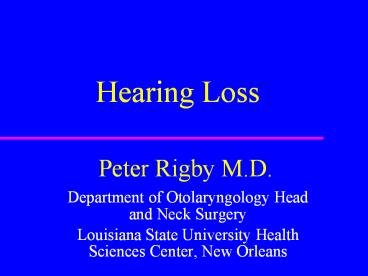Hearing Loss - PowerPoint PPT Presentation
Title:
Hearing Loss
Description:
Hearing Loss – PowerPoint PPT presentation
Number of Views:954
Avg rating:3.0/5.0
Title: Hearing Loss
1
Hearing Loss
Peter Rigby M.D.
- Department of Otolaryngology Head and Neck
Surgery - Louisiana State University Health Sciences
Center, New Orleans
2
Strategies in Patient Management
- Review and compare the clinical presentation of
hearing loss for children and adults - Review diagnostic workup for new onset hearing
loss - Review initial management for new onset hearing
loss
3
Strategies in Patient Management
OLD
YOUNG
4
Strategies in Patient Management
CONDUCTIVE
SENSORINEURAL
5
NORMAL LEFT EAR
6
Epidemiology
- Congenital
- unilateral or mod 50/1000
- Profound SNHL 4/1000
- Genetic SNHL 1/1000
- Adult SNHL (age 65) 166/1000
- Hereditary SNHL 27/1000
- Mature SNHL (age 80) 500/1000
- CHL 10/1000
7
Strategies in Patient Management
Child with newly discovered hearing loss Infant
screening Language delay Difficulty in school
8
Congenital Hearing Loss
Etiology of Congenital Hearing Loss
9
Epidemiology
- Congenital Infection
- Cytomemalovirus
- found in 1-2 of all live births
- Rubella progressive hearing loss
- Syphilis
- measles (rubeola), mumps, toxoplasmosis, herpes
simplex
10
Epidemiology
- Neonatal Infection
- bacterial meningitis
- 7 of all childhood hearing loss
- pneumococcus
- Neisseria Haemophilus influenza
11
Congenital Hearing Loss
Inheritance of Genetic Hearing Loss
12
Genetic Hearing Loss
- Dominant
- every generation
- variable pattern HL
- second to third decade
- Recessive
- skip generations
- HF SNHL
- birth to one year
13
Pregnancy History
- Birth History
- hypoxia
- kernicterus
- toxemia
- prematurity
- medications
- Maternal Infection
- rubella
- CMV
- toxoplasmosis
- medications
14
Postnatal History
- Otologic history
- ototoxic exposure
- noise trauma
- head trauma
- medications
- Infection
- meningitis
- measles
- mumps
- syphilis
- medications
15
Family History
- Consanguinity
- test all siblings
- Two Generations
- hearing loss
- hearing aids
- balance problems
16
Strategies in Patient Management
Adult with hearing loss Sudden loss Progressive
loss Vertigo
17
Medical History
- Vascular
- diabetes
- HTN
- CAD
- CVA
- medications
- Hypercoag
- lipids
- BCPs
- atherosclerosis
- arthritis
- medications
18
Medical History
- Noise trauma
- guns
- military
- machinery
19
Physical Exam
- General
- stature
- milestones
- pigmentation
- hypogonadism
- craniofacial
- Ophthalmologic
- keratitis - syphilis, Cogans
- retinitis pigmentosa - Ushers
- cataracts - NF2 , rubella
- inclusions - CMV, toxo
- visual acuity
20
Physical Exam
- Otologic
- trauma
- malformations
- cholesteatoma
- infection
- Head and Neck
- orbit - Apert, Crousan
- mid face - Treacher Collins, Digeorge, Goldenhar
- mandible - Pierre Robin
- neck- brachio-oto-renal, Pendred
21
Audiogram left conductive loss
22
Audiogram left sensorineural loss
23
Weber test left hearing loss
SENSORINEURAL
CONDUCTIVE
24
Rinne test left hearing loss
SENSORINEURAL
CONDUCTIVE
LOUDER!
LOUDER!
25
(No Transcript)
26
Laboratory Testing
- Renal Function
- BUN
- Creatinine
- Urinalysis
- Hematuria
- Proteinuria
- Alports, polycystic kidney disease
- Metabolic
- TFTs - Pendred, cretinism
- glucose - diabetes
- CBC - infection, discraisas
27
Laboratory Testing
- Immune
- Sed rate
- ANA, RF
- Western Blot
- Connexin 26
- Cogans
- 68 kd Protein
- Serology
- RPR/ FTA-ABS
- TORCH
- Toxoplasmosis
- Rubella
- cytomegalovirus
- herpes
28
Laboratory Testing
- CT temporal bones
- mondini
- vestibular aqueduct
- cochlear aqueduct
- cholesteatoma
- osteodysplasia
- osteogenesis imperfecta, Stickler,
- ECG
- prolonged QT
- peaked T
- Jervell and Lange-Neilson
29
Laboratory Testing
- MRI temporal bones
- Acoustic neuroma
- Facial schwannoma
- Multiple sclerosis
- Cholesteatoma
- encephalocele
- Central axis tumors
30
Intervention
- Treatable causes
- PLF
- immune
- hydrops
- otosclerosis
- tumor
- hypercoag
- Information
- cause
- progression
- family risk
- family testing
- resources
31
Intervention
- Systemic Rx
- eyes
- cardiac
- vascular
- renal
- thyroid
- tumor
- Hearing Rx
- seating
- amplification
- vision
- qued speech
- cochlear implants
- sign
32
Ossicular Fixation
- Audiogram
- CT- Coronal
- ossicles, middle ear size, oval window, facial
nerve, otic capsule, IAC - vestibular aquaduct
- cochlear aquaduct
- Watch out for SNHL,
- balance symptoms
33
Stapes Fixation
- juvenile otosclerosis
- Treacher Collins
- Klippel-Feil
- Pfeiffer
- branchio-oto-renal
- ear pits-deafness
- cervico-acoustic syndromes
- Crouson
- X linked mixed deafness with gusher
- osteogenesis imperfecta
34
Atresia
- 110,000 - 120,000
- 1/3 bilateral
- usually asymmetric defects
35
Atresia Timing
- Bilateral Atresia
- Audiometric evaluation early
- Amplify early
- Auditory/Speech assistance in school
- CT age 4-5
- Repair age 6
- Unilateral Atresia
- Audiometric evaluation early
- Amplify usually not accepted
- CT age 4-5 (also screen for canal cholest)
- balance need/timing of repair with risks
36
Herpes zoster oticus
37
Polyp in ear canal
38
(No Transcript)
39
(No Transcript)
40
Acute otitis media
41
tympanosclerosis
42
cholesteatoma
43
cholesteatoma
44
Chronic otitis media Cholesteatoma tympanosclerosi
s
45
aspergillosis
46
Basal cell carcinoma
47
(No Transcript)
48
Squamous Cell carcinoma
49
Conclusion
- A stepwise approach to hearing loss evaluation
aids in identification of etiology without
excessive testing - Workup should be tailored to age, history, and
early examination of the ear - Workup should be directed at treatable causes

